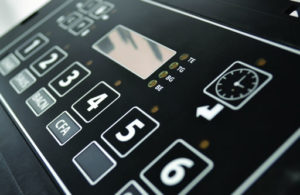
Capacitive switches have become a popular alternative to mechanical switches. As their name suggests, they leverage capacitance. Capacitive switches measure changes in capacitance, and they use this information to open or close a circuit. Pressing a capacitive switch your finger will absorb some of its electrical charge, resulting in a change of capacitive.
Like all switches, capacitive switches feature an overlay. The overlay is the uppermost layer. It displays the graphics that denote the respective buttons. To use a capacitive switch, you’ll need to press — or at least touch — the overlay.
While all capacitive switches have an overlay, the specific type of overlay used in their construction may vary. There are different types of overlays. If you’re planning to buy a capacitive switch, you should consider the overlay.
Overlay Materials
You can find overlays made of different materials. Some of the most common overlay materials for capacitive switches include plastic, acrylic and glass. Capacitive switches may feature other materials in their underlying layers. Overlays, though, are usually made of either plastic, acrylic or glass.
Plastic overlays are inexpensive and long-lasting. Acrylic overlays, on the other hand, offer a superior level of strength and durability. With that said, some people prefer glass overlays. Plastic, acrylic and glass are all transparent materials. Glass overlays, though, offer the highest level of optical clarity. Regardless, not all capacitive switches feature the same type of overlay. Some of them have a plastic overlay, whereas others have an acrylic or glass overlay.
Overlay Adhesive
Some capacitive switches feature adhesive on their overlay. Adhesive is used to bind the overlay to an underlying layer. It’s important that the adhesive fully covers the back side of the overlay. If there are gaps, it will reduce the dielectric constant of the capacitive switch. Jargon aside, capacitive switches may fail to register button presses if there are gaps in the adhesive.
Any adhesive applied to the overlay must also be nonconductive. Capacitive switches use a similar method of operation as capacitive touchscreens: They require contact with a conductive object. Touching a conductive object, such as a bare finger, on a capacitive switch will change its capacitance. If the adhesive is conductive, it may interfere with the capacitive switch’s operations.
In Conclusion
Capacitive switches are designed with a top layer. Known as an overlay, it typically consists of a thin sheet of plastic, acrylic or glass with the graphics printed on it.
